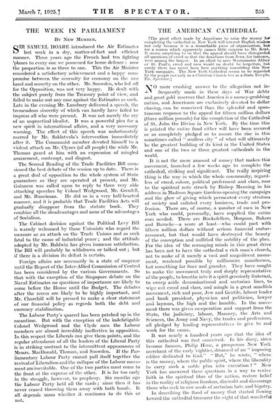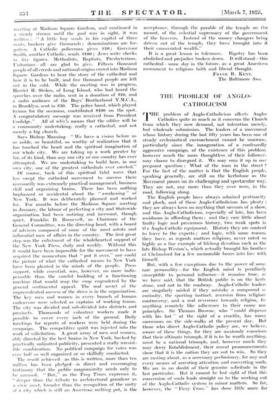THE AMERICAN CATHEDRAL
• [The great effort made by Americans .to raise the money foe completing the cathedral in New York will interest English readers not only because it is a remarkable piece of :organization, bob for a reason which apparently causes little surprise to Mr. Kent. It seems surprising to us that the appeal should have disregarded all questions of creed so that the donations from Jews, for instance. were among the largest. In an effort to save Westminster Abbey or St. Paul's, creed and race would no doubt be forgotten, but surely there has never been here anything resembling this New York campaign. The. New York Cathedral seems to be regarded by the people not only as a Christian Church but as a State Temple. ED. Spectator.] No more crushing answer to the allegation not in- frequently made in these days of War debts and great gold reserves that America is a money-grubbing nation, and Americans are exclusively devoted to dollar chasing, can be • conceived than the splendid and spon- taneous .response to the appeal for fifteen million dollars (three million pounds) for the• completion -a the Cathedral of St. John the Divine in New York. By the time this is printed the entire fund either will have been secured or so completely pledged as to assure the rise in this sometimes called " soulless city " of what will ultimately be the greatest building of its kind in the United States and one of the two or three greatest cathedrals in the world.
It is not the mere amount of money that makes this movement, launched a few weeks ago to complete the cathedral, striking and significant. The really inspiring thing is the way in which the whole community, regard- less of creed, colour, political preferment and class, rose to the spiritual note struck by Bishop Manning in his address in Madison Square. Gardens opening the campaign and the glow of giving which permeated every stratum of society and enlisted every business, • trade and pro- fession. There arc, of course, a number of men in New York who could, personally, have supplied the entire sum needed. There are Rockefellers, Morgans, Bakers and Baruehs—a score at least—who could part with fifteen million dollars without serious financial embar- rassment, but that would have destroyed the beauty of the conception and nullified the nobility of the plan. For the idea of the managing minds in this .great drive has been not to have the cathedral a rich man's church, not to make of it merely a vast and magnificent monu- ment, rendered possible by millionaire munificence, but something far finer and grander. They have sought to make the movement truly and deeply representative of the people, to breathe into it a spirit genuinely fraternal, to sweep aside denominational and sectarian lines, to .wipe out creed and class, and mingle in a great unselfish movement, rich and poor, Jew and Gentile, labour leader and bank president, physician and politician, lawyer and layman, the high and the humble. In the move- ment.there was given co-operation and support from the State, the judiciary, labour, Masonry, the Arts and Sciences, the Army and Navy, the trades and professions, all pledged by leading representatives to give to and work for the cause.
It was nearly a hundred years ago that the idea or this cathedral was first conceived. In his diary, since become famous, Philip Hone, a prosperous New York merchant of the early 'eighties, dreamed of an " imposing edifice dedicated to God." " But," lie wrote, " where is the money, where the public spirit, where the liberality to carry such a noble plan into execution ? " New York has answered these questions in a way to revive faith in the spiritual fibre of the nation, restore belief in the reality of religious freedom, discredit and discourage those who seek to sow seeds of sectarian hate and bigotry.
In describing the flood of money that started flowing toward the cathedral treasurer the night of that wonderful meeting at Madison Square Gardens, and continued in a steady stream until the goal was in sight, it was written : --" A little boy sends in his capital of three cents, bankers give thousands ; denominations are for- gotten. A Catholic policeman gives $10 ; Governor Smith, another Catholic, sends 8100 ; Jews write checks in five figures. Methodists, Baptists, Presbyterians, Unitarians—all--are glad to give. Fifteen thousand people of all creeds and national origins crowd into Madison Square Gardens to hear the story of the cathedral and how it. is to be built, and five thousand people are left out in the cold. While the meeting was in progress, Harriet R. Stokes, of Long Island, who had heard the speeches over the radio, sent in a donation of $10, and a radio audience of the Boys' Brotherhood Y.M.C.A., in Brooklyn, sent in $50. The police band, which played hymns for the occasion, contributed $100 on the spot. A congratulatory message was received from President Coolidge." All of which means that the edifice will be a community undertaking, really a cathedral, and not merely a big church.
Says Bishop Manning—" We have a vision before us so noble, so beautiful, so worthy of realization that it has touched the heart and the spiritual imagination of our whole city. We are taking up a work greater by far, of its kind, than any our city or our country has ever attempted. We are undertaking to build here, in our own city, one of the greatest cathedrals ever erected."
Of course, back of this spiritual tidal wave that has swept the cathedral movement to success there necessarily was extremely practical management, business skill and organizing brains. There has been nothing haphazard or accidental about the " awakening " of New York. It was deliberately planned and worked for. For months before the Madison Square meeting in January, the labour of perfecting a city and Statewide organization had been untiring and incessant, though quiet. Franklin D. Roosevelt, as Chairman of the General Committee, was the directing head, with a board of advisers composed of some of the most astute and influential men of affairs in the country. The first great step was the enlistment of the wholehearted support of the New York Press, daily and weekly. Without this it would have been impossible for the movement to have acquired the momentum that " put it over," nor could the picture of what the cathedral means to New York have been planted -in the minds of the people. Press support, while essential, was, however, no more indis- pensable than the careful building of a functioning machine that would reap the crop engendered by the general sentimental appeal. The real secret of the unprecedented success of the drive is in the organization. The key men and women in every branch of human endeavour were selected as captains of working teams. The city was divided and sub-divided into districts and precincts. Thousands of volunteer workers made it possible to cover every inch of the ground. Daily meetings for reports of workers were held during the campaign. The competitive spirit was injected into the work of solicitation. A great army of men and women, ably directed by the best, brains in New York, backed by practically unlimited publicity, presented a really irresist- ible combination. No political campaign for votes was ever half so well organized or so skilfully conducted.
The result achieved----as this is written, more than ten million has been pledged—is direct and encouraging testimony that the public magnanimity needs only to be aroused. " But," as the Troy Times expresses it, " deeper than the .tribute to architectural grandeur as a civic asset, broader than the recognition of the unity of a city which is still an American melting pot, is the acceptance, through the parable of the temple on the mount, of the celestial supremacy of the government of the heavens. Instead of the money changers being driven out of the temple, they have brought into it their consecrated wealth."
It is a great lesson in tolerance. Bigotry has been abolished and prejudice broken down. It will stand—this cathedral—sonic day in the future, as a great American monument to religious faith and liberal thought.
FRANK R. KENT,
The Baltimore Sun.



























































 Previous page
Previous page